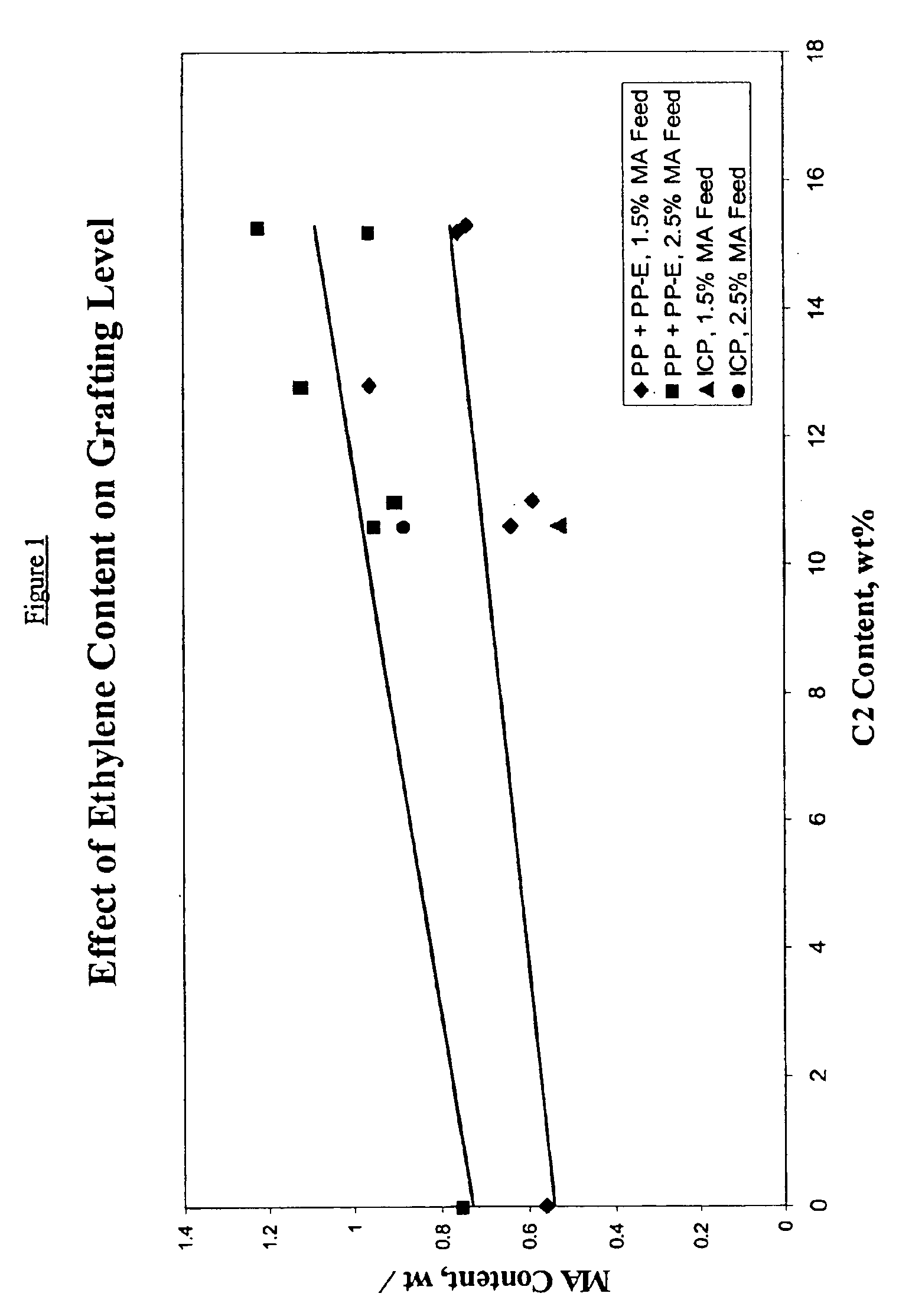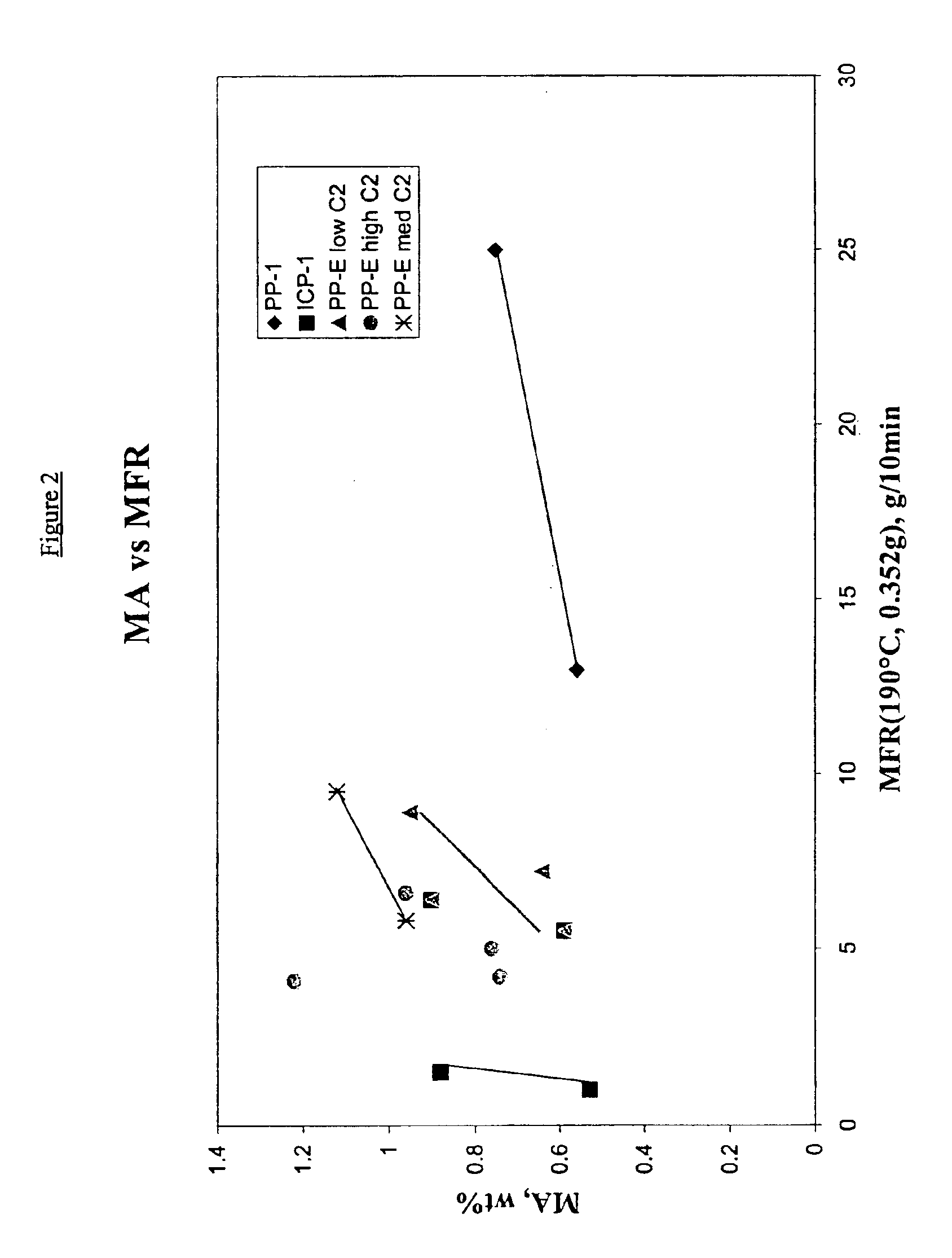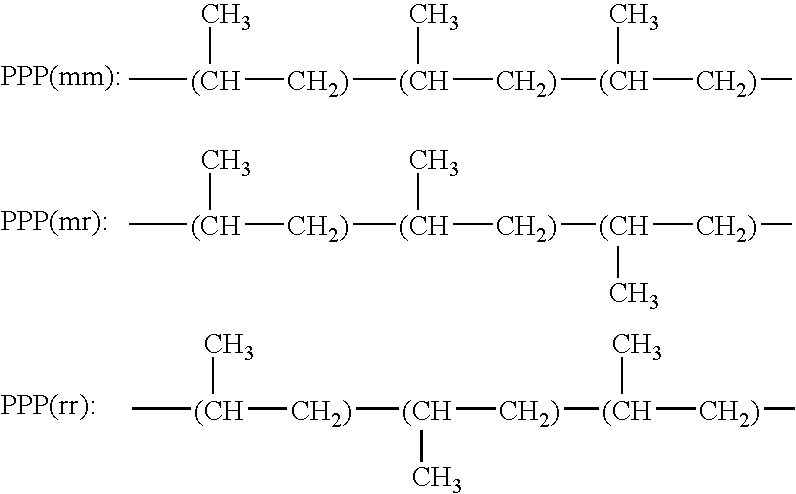Graft-modified polymers based on novel propylene ethylene copolymers
a technology of propylene ethylene and polyethylene, which is applied in the field of new graft reaction products of propylene/ethylene copolymers and maleic anhydride, can solve the problems of poor elastic properties of grafted polyolefins, particularly of propylene in predominantly isotactic configuration, and none of these publications address the formation of a essentially propylene copolymer
- Summary
- Abstract
- Description
- Claims
- Application Information
AI Technical Summary
Benefits of technology
Problems solved by technology
Method used
Image
Examples
example 1
Ethylene & Propylene Copolymerization to Form the Propylene Ethylene Copolymer
[0078]Continuous polymerization of the propylene ethylene copolymer was conducted in a 9 liter Continuous Flow Stirred Tank Reactor using hexane as the solvent. The liquid full reactor had a residence time of 9 minutes and the pressure was maintained at 700 kpa. A mixed feed of hexane, ethylene and propylene was pre-chilled to approximately −30° C. to remove the heat of polymerization, before entering the reactor. Solution of catalyst / activator in toluene and the scavenger in hexane were separately and continuously admitted into the reactor to initiate the polymerization. The reactor temperature was maintained between 35° C. and 50° C., depending on the target molecular weight. The feed temperature was varied, depending on the polymerization rate to maintain a constant reactor temperature. The polymerization rate was varied from about 0.5 Kg / hr to about 4 Kg / hr.
[0079]Hexane at 30 Kg / hr was mixed with ethyl...
example 2
Grafting Maleic Anhydride to the Homopolymer Polypropylene (Comparative)
[0081]PP-1 (see Table 1) was grafted on a non-intermeshing counter-rotating twin screw extruder (30 mm, L / D=48) under the following conditions: 97.5 to 98.5 weight % of polymer, 2.5-1.5 weight % of Crystalma™ Maleic Anhydride were fed at 7kg / h feed rate to the hopper of the extruder and 0.24-0.4 weight % of a 10% solution of Luperox™ 101 dissolved in Marcol™ 52 oil were added to the second barrel. The screw speed was set at 125 rpm and following temperature profile was used: 180° C., 190° C., 190° C., 190° C. with the die at 180° C. Excess reagents as well as peroxide decomposition products were removed with vacuum prior to polymer recovery.
Table 1 describes the polymers that were grafted in the following examples.
[0082]
TABLE 1MFR (190° C., 2.16 kg),Backboneg / 10 minML (1 + 4), 125° C.C2, wt %PP-11.3na0ICP-11na10.6PP-E-12.81210.6PP-E-22.71315.2PP-E-33.31112.8PP-E-41.62015.3PP-E-50.753111PP-1 is a PP homo-polymer,...
example 3
Grafting Maleic Anhydride to the Impact Copolymer Polypropylene (Comparative)
ICP-1 and ICP-2 were grafted under the same set of conditions as described in example 2. Characteristics of the grafted polymers are given in Table 3.
[0084]
TABLE 3MFR (190° C.,GraftedFeeds, %0.352 g)MAGraft #BackbonePolymerMAL101g / 10 minwt % 3ICP-198.51.50.2410.534ICP-197.52.50.401.50.88Compared to PP-1, the ICP-1 gives slightly higher grafting with much lower viscosity reduction.
PUM
| Property | Measurement | Unit |
|---|---|---|
| Temperature | aaaaa | aaaaa |
| Temperature | aaaaa | aaaaa |
| Fraction | aaaaa | aaaaa |
Abstract
Description
Claims
Application Information
 Login to View More
Login to View More - R&D
- Intellectual Property
- Life Sciences
- Materials
- Tech Scout
- Unparalleled Data Quality
- Higher Quality Content
- 60% Fewer Hallucinations
Browse by: Latest US Patents, China's latest patents, Technical Efficacy Thesaurus, Application Domain, Technology Topic, Popular Technical Reports.
© 2025 PatSnap. All rights reserved.Legal|Privacy policy|Modern Slavery Act Transparency Statement|Sitemap|About US| Contact US: help@patsnap.com



